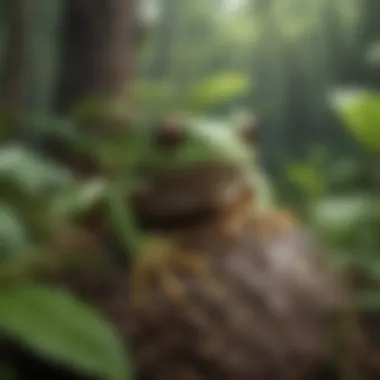Unraveling the Enigmatic World of Tree Frog Poison


Nature Topic Overview
Tree frogs are fascinating amphibians that intrigue researchers and nature enthusiasts alike. They boast a unique defense mechanism in the form of their poisonous secretions. This article will delve into the intricate world of tree frog poison, unveiling the captivating characteristics and mechanisms behind this natural defense strategy.
Fun Facts and Trivia
Through the tale of tree frog poison, young readers can explore intriguing facts about these amphibians. Did you know that some tree frog species can excrete toxins through their skin to deter predators? This provides an interactive element for engaging young minds, fostering a love for wildlife and the wonders of nature.
Wildlife Explorations
Embark on a journey to discover the diverse species of tree frogs and the habitats they inhabit. From the vibrant hues of the green tree frog to the camouflage techniques of the gray tree frog, each species has unique adaptations that enable them to thrive in their environments. Dive into interactive features like quizzes to test your knowledge on these enchanting amphibians.
Environmental Awareness
The conservation of tree frogs and their habitats is crucial for preserving biodiversity. Children can learn about the importance of sustainability and ways to protect these fascinating creatures. Tips on creating frog-friendly environments in backyards and communities empower young nature enthusiasts to make a positive impact on the environment.
DIY Nature Activities
For young explorers eager to delve further into the world of tree frogs, engaging in hands-on activities is a fun and educational way to learn. Create a frog habitat in your backyard using simple materials, and observe these amphibians up close. Step-by-step guides for crafting nature-inspired projects will fuel creativity and nurture a deeper connection with the natural world.
Introduction to Tree Frogs
As we embark on a fascinating journey into the world of tree frog poison, it is crucial to first understand the importance of comprehending the behavior and characteristics of tree frogs. These amphibians hold a unique place in the ecosystem, showcasing distinct behaviors and adaptations that contribute to their survival. By delving into the realm of tree frog behavior, we uncover a tapestry of nocturnal habits, tree climbing adaptations, and communicative calls that define these species. It is through understanding these elements that we gain valuable insight into the intricate lives of tree frogs.


Understanding Tree Frog Behavior
Nocturnal Habits: In the dim light of night, tree frogs exhibit remarkable behaviors that set them apart in the animal kingdom. Their nocturnal habits allow them to thrive in the cover of darkness, seeking prey while evading predators. The silent rustle of leaves as they move with stealth portrays the essence of these creatures' nocturnal prowess. This adaptation not only offers them protection but also enhances their hunting efficiency, making it a strategic choice for survival in their habitat.
Tree Climbing Adaptations: Tree frogs are masterful climbers, equipped with specialized adaptations that enable them to traverse complex arboreal landscapes effortlessly. Their remarkable toe pads, designed for gripping various surfaces, showcase the ingenuity of nature in tailoring adaptations to their environment. This unique feature empowers tree frogs to navigate vertically and horizontally with precision, a crucial advantage for evading threats and accessing resources in their habitat.
Communicative Calls: The symphony of sound that resonates through the rainforest night belongs to the tree frogs' communicative calls. These vocalizations serve as a means of marking territory, attracting mates, and signaling danger. Each species exhibits a unique call, reflecting the diversity and complexity of their communication methods. From melodious trills to rhythmic chirps, these calls play a pivotal role in the social dynamics and reproductive success of tree frog populations.
Diversity of Tree Frog Species
Tropical Varieties: The lush tropics host a myriad of tree frog species, each adapting to the vibrant ecosystem in distinct ways. Tropical tree frog varieties showcase a remarkable array of colors, patterns, and behaviors, reflecting the rich biodiversity of their habitats. Their adaptations to humid conditions, abundant rainfall, and dense vegetation highlight their resilience in tropical ecosystems, making them a focal point of ecological intrigue.
Global Distribution: From the pristine rainforests of South America to the subtropical regions of Asia, tree frogs inhabit diverse global landscapes with adaptability and grace. Their global distribution reveals the versatility of these amphibians in thriving across varied climates and terrains. The cosmopolitan presence of tree frog species underscores their evolutionary success and ecological significance on a worldwide scale.
Tree Frog Poison Mechanism
Tree frog poison mechanism is a captivating subject that delves deep into the intricate defense strategies of these amphibians. The secretion of toxic compounds serves as a natural defense mechanism against predators, highlighting the evolutionary adaptations of tree frogs. By exploring the chemical composition of their toxins, we uncover the fascinating world of tree frog defenses.
Chemical Composition of Tree Frog Toxins
When examining the chemical composition of tree frog toxins, two significant components come to the forefront: alkaloids and steroid compounds.
Alkaloids
Alkaloids play a crucial role in tree frog toxins, imparting unique bioactive properties that contribute to their defensive capabilities. These compounds possess intricate molecular structures that interact with predator physiology, leading to a potent defensive response. The presence of alkaloids in tree frog secretions signifies a sophisticated adaptation to deter potential threats, showcasing the complexity of nature's defensive mechanisms.


Steroid Compounds
Steroid compounds in tree frog toxins offer a different dimension to their defensive arsenal. These compounds exhibit distinct chemical properties that augment the overall toxicity of the secretion. Through the strategic combination of alkaloids and steroid compounds, tree frogs establish a formidable defense mechanism that aids in their survival in challenging environments.
Adaptive Significance of Poison Glands
The adaptive significance of poison glands in tree frogs is multifaceted, providing insight into the evolutionary advantages of these specialized structures.
Predator Deterrence
One significant aspect of poison glands is predator deterrence. The toxins produced by tree frogs act as a powerful deterrent against predators, warning them of the potential risks associated with preying on these amphibians. This adaptative strategy enhances the tree frog's chances of survival in the wild by minimizing predation risks.
Survival Advantage
Another critical aspect is the survival advantage conferred by poison glands. By evolving specialized glands that produce toxic secretions, tree frogs gain a competitive edge in their ecosystems. This survival advantage enables tree frogs to navigate complex ecological dynamics and thrive in their natural habitats, showcasing the intricate balance of nature's evolutionary processes.
Implications of Tree Frog Toxins
Tree frog toxins have significant implications within the realm of toxicology and biological research. Their complex chemical composition, consisting of alkaloids and steroid compounds, presents a rich field for exploration. Through studying these toxins, researchers have unlocked potential avenues in biomedical research that could revolutionize drug development and therapeutic applications.
Biomedical Research Applications
Tree frog toxins offer a promising frontier in the realm of drug development. Their unique chemical properties, especially the alkaloids and steroid compounds, showcase potent therapeutic effects that could pave the way for novel medications. Leveraging these compounds in pharmaceutical research opens doors to innovative treatments for various ailments, demonstrating the inherent value of tree frog toxins in advancing healthcare.
- Drug Development Potential: The drug development potential of tree frog toxins lies in their ability to target specific biological pathways effectively. By harnessing the medicinal qualities of these toxins, researchers can design drugs with enhanced efficacy and reduced side effects, marking a significant step forward in pharmacological advancements.
- Therapeutic Uses: The therapeutic potential of tree frog toxins extends to a wide array of medical applications. From pain management to neurological disorders, these toxins exhibit versatile healing properties that hold promise for personalized medicine and targeted therapies. Embracing the therapeutic uses of these compounds brings us closer to unlocking nature's pharmacy for human well-being.


Ecological Importance
Beyond their merit in scientific research, tree frog toxins play a pivotal role in maintaining ecological balance. Their interactions within ecosystems and contribution to the delicate equilibrium of nature stand as testaments to the intricate web of life. Understanding the ecological importance of these toxins sheds light on the interconnectedness of species and the profound impact of biodiversity conservation.
- Ecosystem Interactions: Tree frog toxins not only shape predator-prey dynamics but also influence community structuring within ecosystems. By exerting selective pressures on other organisms, these toxins sculpt the biodiversity of habitats, underscoring their role in shaping ecological interactions. Exploring the nuances of ecosystem interactions bolster our appreciation for the delicate ecological tapestry woven by these amphibians.
- Balance in Nature: The presence of tree frog toxins underscores the significance of balance in nature. Through their chemical defenses, tree frogs contribute to the regulation of population sizes and the maintenance of biodiversity. The delicate balance maintained by these toxins highlights the intricate mechanisms of nature's checks and balances, emphasizing the fragility and resilience inherent in our natural world.
Conservation Concerns and Future Outlook
As we traverse the enthralling realm of tree frog poison, it becomes evident that delving into conservation concerns and future outlook is paramount. The preservation of habitats that house these incredible amphibians is crucial due to their unique roles in maintaining ecological balance. By protecting tree frog habitats, we not only safeguard these species but also preserve the delicate interconnectedness of ecosystems. Furthermore, considering the ongoing challenges such as deforestation and climate change, it is imperative to strategize for the future, ensuring these mesmerizing creatures thrive for generations ahead.
Habitat Loss Impact
Deforestation Effects
Within the context of tree frog poison exploration, the ramifications of deforestation are profound. Deforestation eradicates vital tree cover crucial for tree frogs, disrupting their natural habitats and breeding grounds. The consequential habitat loss directly threatens the survival of tree frog populations and diminishes the biodiversity of ecosystems. The stark reality of deforestation effects underscores the urgent need for sustainable practices to mitigate further harm and preserve the intricate web of life that these amphibians are an intrinsic part of.
Climate Change Risks
In the tapestry of tree frog poison narratives, climate change emerges as a formidable risk factor. The escalating changes in climatic patterns pose challenges to tree frog populations, affecting their reproductive cycles, behavior, and habitat suitability. The insidious impact of climate change exposes tree frogs to unprecedented survival hurdles, warranting adaptive strategies and heightened vigilance. Acknowledging the intersection of climate change and tree frog habitats is pivotal in designing holistic conservation approaches for safeguarding these captivating amphibians.
Sustainable Conservation Strategies
Diving deeper into the mosaic of tree frog poison revelations, sustainable conservation strategies offer a glimmer of hope amidst prevailing challenges. Protected areas serve as sanctuaries for tree frogs, preserving their habitats from encroaching threats and providing safe havens for thriving populations. The intrinsic value of protected areas lies in their capacity to uphold biodiversity and foster species resilience, reflecting a harmonious coexistence between nature and conservation efforts.
Protected Areas
Evaluating the essence of protected areas within the narrative of tree frog poison elucidates their pivotal role in safeguarding these vulnerable amphibians. Protected areas act as refuges shielded from external disturbances, enabling tree frogs to flourish undisturbed. The designation of protected areas underscores a commitment to conservation, signaling an unwavering dedication to preserving biodiversity and nurturing thriving ecosystems.
Community Involvement
Venturing into the realm of community involvement in tree frog poison discourse unveils collaborative approaches driving conservation initiatives forward. Community engagement empowers local stakeholders to actively participate in preserving tree frog habitats, fostering a sense of stewardship and collective responsibility. The symbiotic relationship between communities and tree frog conservation amplifies the impact of conservation efforts, leading to sustainable outcomes and enduring conservation legacies.







